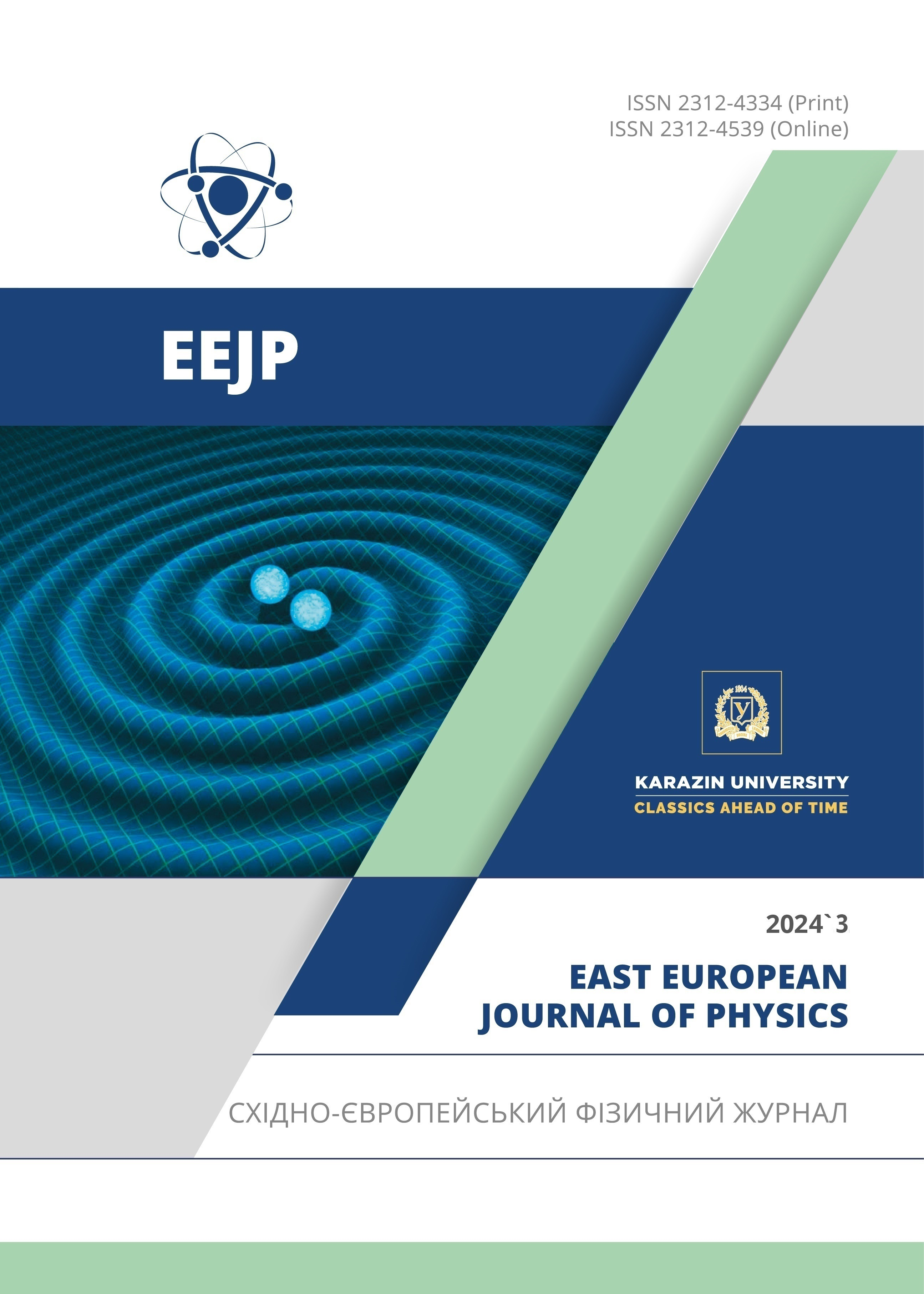The Mechanism of Current Transfer in n-GaAs – p(ZnSe)1-x-y(Ge2)x(GaAs1–δBiδ)y Heterostructures
Abstract
The I-V characteristics of heterostructures n-GaAs – p-(ZnSe)1–x–y(Ge2)x(GaAs1–δBiδ) exhibit a characteristic quadratic law - J~V2 I-V curve, followed by a sharp pre-breakdown current growth, which well explains the observed straight branch of the I-V characteristics and this regularity remains unchanged at different temperatures. The analysis of the I-V characteristics of n‑GaAs‑p‑(ZnSe)1‑x‑y(Ge2)x(GaAs1–δBiδ) heterostructures with an extended intermediate solid solution layer shows that the drift mechanism of charge transport predominates under forward bias conditions.
Downloads
References
V.P. Makhni, M.M. Sletov, and I.V. Tkachenko, “The nature of the green luminescence band in zinc selenide crystals,” Journal of Optical Technology, 74(6), 394-396 (2007). https://doi.org/10.1364/JOT.74.000394
V.P. Makhni, M.M. Sletov, and S.V. Khusnutdinov, “Preparation of ZnO Heterolayers on Zinc Chalcogenide Substrates,” Inorganic Materials, 43(12) 1304–1306 (2007). https://doi.org/10.1134/S0020168507120096
V.P. Makhniy, M.M. Slyotov, and S.V. Khusnutdinov, “Luminescence of zinc oxide layers synthesized on zinc selenide substrates by the isovalent substitution method,” Russian Physics Journal, 52(2), 216-217 (2009).
A. Gangopadhyay, “Investigation of Strain Relaxation Mechanisms and Interfacial Defects in Lattice-mismatched GaAs(001)-based Heterostructures,” PhD Thesis, Arizona State University, May 2021, pp.136.
L.G. Wang, and A.Z. Dilute, “Dilute nonisovalent (II-VI)-(III-V) semiconductor alloys: Monodoping, codoping, and cluster doping in ZnSe-GaAs,” Physical Review B, 68, 125211 (2003). https://doi.org/10.1103/PhysRevB.68.125211
A.Y. Boboev, “Structural features, electrophysical and photoelectric properties of n- (GaAs)-p-GaAs)1-x-y(Ge2)x(ZnSe)у heterostructures,” PhD Thesis, Tashkent, IFPM, 2019, 128 p.
S. Zainabidinov, Sh. Utamuradova, and A. Boboev. “Structural Peculiarities of the (ZnSe)1–x–y(Ge2)x(GaAs1–δBiδ)y Solid Solution with Various Nanoinclusions,” Journal of Surface Investigation X-ray Synchrotron and Neutron Techniques, 16(6),1130-1134 (2022). https://doi.org/10.1134/S1027451022060593
S. Zaynabidinov, A. Saidov, A. Boboev, and D. Abdurahimov, “Structure, Morphology and Photoelectric Properties of n-GaAs-p-(GaAs)1--x(Ge2)х Heterostructure,” Herald of the Bauman Moscow State Technical University, Series Natural Sciences, 100(1), 72-87 (2022). https://doi.org/10.18698/1812-3368-2022-1-72-87
O.O. Mamatkarimov, O. Himmatkulov, and I.G. Tursunov, “Effect of Uniaxial Elastic Deformation on the Current–Voltage Characteristic of Surface-Barrier Sb–p-Si〈Mn〉–Au Diodes,” Semiconductors, 54(5), 563–566 (2020). https://doi.org/10.1134/S1063782620050085
A.S. Saidov, A.Yu. Leiderman, Sh.N. Usmonova, and U.P. Asatova, “Peculiarities of the Current–Voltage Characteristic of n-GaP–p-(InSb)1–x(Sn2)x Heterostructures,” Technical Physics Letters, 46(11), 1124–1127 (2020). https://doi.org/10.1134/S1063785020110279
A.Yu. Leiderman, and M.K. Minbaev, “A mechanism of rapid growth of direct in semiconductor diode structures,” FTP, 30(10), 1729-1738 (1996). (in Russian)
Sh.A. Mirsagatov, A.Yu. Leiderman, and O.K. Ataboev. “Mechanism of Charge Transfer in Injection Photodiodes Based on the In–n+CdS–nCdSxTe1–x–pZnxCd1–xTe–Mo Structure,” Physics of the Solid State, 55(8), 1635–1646 (2013). https://doi.org/10.1134/S1063783413080192
A.Yu. Leiderman, and P.M. Karageorgy-Alkalaev, “On the theory of sublinear current-voltage characteristics of semiconductor structures,” Solid State Communications, 25(10), 781-783 (1978). https://doi.org/10.1016/0038-1098(78)90239-9
P.M. Karageorgy-Alkalaev, and A.Yu. Leiderman, “Statistics of Inter-Impurity Recombination of Electrons and Holes in Semiconductors,” Physica status solidi (b). 26(2), 419-428 (1968). https://doi.org/10.1002/pssb.19680260204
A.Yu. Leiderman, “Possible Influence of Nonequilibrium Carrier Recombination Rate Saturation on Photocell Operation,” Applied Solar Energy, 44(2), 79–81 (2008). https://doi.org/10.3103/S0003701X08020035
Copyright (c) 2024 Sirajidin S. Zainabidinov, Khotamjon J. Mansurov, Akramjon Y. Boboev, Jakhongir N. Usmonov

This work is licensed under a Creative Commons Attribution 4.0 International License.
Authors who publish with this journal agree to the following terms:
- Authors retain copyright and grant the journal right of first publication with the work simultaneously licensed under a Creative Commons Attribution License that allows others to share the work with an acknowledgment of the work's authorship and initial publication in this journal.
- Authors are able to enter into separate, additional contractual arrangements for the non-exclusive distribution of the journal's published version of the work (e.g., post it to an institutional repository or publish it in a book), with an acknowledgment of its initial publication in this journal.
- Authors are permitted and encouraged to post their work online (e.g., in institutional repositories or on their website) prior to and during the submission process, as it can lead to productive exchanges, as well as earlier and greater citation of published work (See The Effect of Open Access).








